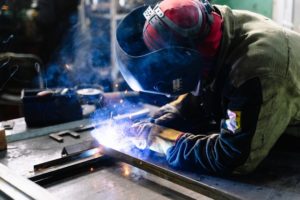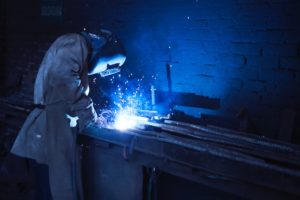The ability to harness great power in one’s own hands serves as one of the main appeals to hobbyist welders. The welding process understandably tantalizes countless amateur welders every year, aweing them with the incredible amount of energy required to fuse metals together. However, this power comes with some dangerous downsides as well. It is crucial that new welders thoroughly understand the proper safety measures so far as to not seriously harm themselves or others during the welding process.
 The first priority in welding safety involves appropriate protection of the body. When a welder wears the correct personal protection equipment (PPE), they minimize the chance of receiving significant bodily harm from the welding process. In welding, PPE must adequately shield the user from head to toe. In fact, welding requires multiple levels of defense over their face alone. Every welder needs to wear a protective helmet to guard the user from sparks or spatter shooting off from the weld. Goggles are also necessary, as some debris can ricochet under the helmet and shoot into a welder’s eye area. The UV rays beaming out of an open arc can literally blind unprotected eyes, so every person around the weld must wear filtered lenses to prevent permanent damage to their eyesight. Ears require constant protection from either earplugs or muffs, as sparks that escape into an ear canal will immediately and permanently cauterize the eardrum.
The first priority in welding safety involves appropriate protection of the body. When a welder wears the correct personal protection equipment (PPE), they minimize the chance of receiving significant bodily harm from the welding process. In welding, PPE must adequately shield the user from head to toe. In fact, welding requires multiple levels of defense over their face alone. Every welder needs to wear a protective helmet to guard the user from sparks or spatter shooting off from the weld. Goggles are also necessary, as some debris can ricochet under the helmet and shoot into a welder’s eye area. The UV rays beaming out of an open arc can literally blind unprotected eyes, so every person around the weld must wear filtered lenses to prevent permanent damage to their eyesight. Ears require constant protection from either earplugs or muffs, as sparks that escape into an ear canal will immediately and permanently cauterize the eardrum.
Moving down on the body, welders should adorn their torsos with flame-resistant aprons, preferably manufactured from leather. An apron serves to prevent radiant energy and sparks from burning through the welder’s clothing and harming the user. Similarly, all welders should wear flame-resistant gloves to guard their hands from the intense heat generated from a weld. These gloves should still remain on a welder’s hands when handling recently welded material, which is still likely to burn one’s hands. The remainder of a welder’s garments should be composed of heavy materials that are unlikely to deteriorate from heat. Lighter materials can lead to painful burns if sparks manage to melt through clothing and onto the skin of the welder. To avoid sparks entirely, absolutely no skin should be showing on a welder’s body. Shorts, t-shirts, and sandals are all expressly forbidden in workspaces because of their excessive exposure of the welder’s body. If a welder does happen to get burned, they need to immediately douse themselves in cold water to curtail the damage of the injury.
 After purchasing the necessary PPE, the welder should scan for any potential hazards in the workspace and prepare to remove them. Welders can never weld on or near any materials that have been cleaned with chlorinated hydrocarbons, which create the fatally poisonous phosphine gas when combined with the UV light from an open arc. Welders must also remove all flammable materials from the welding area, including any object that has been exposed to a flammable liquid. Finally, the welder must ensure that the welding area is completely dry and remove all puddles of water to prevent electrocution.
After purchasing the necessary PPE, the welder should scan for any potential hazards in the workspace and prepare to remove them. Welders can never weld on or near any materials that have been cleaned with chlorinated hydrocarbons, which create the fatally poisonous phosphine gas when combined with the UV light from an open arc. Welders must also remove all flammable materials from the welding area, including any object that has been exposed to a flammable liquid. Finally, the welder must ensure that the welding area is completely dry and remove all puddles of water to prevent electrocution.
Even after the welder removes hazards from the workplace, they still need to curate proper ventilation for proper safety. Ventilation serves two key roles for welding safety: it prevents the displacement of oxygen and it removes airborne contaminants. The displacement of oxygen by fumes and gases can lead to asphyxiation and even death; meanwhile, certain contaminants cause severe illnesses and chronic health problems. Fortunately, if a workspace meets certain guidelines, than the welder will only need to utilize natural ventilation to facilitate a safe workspace. The creation of natural ventilation entails the flow of air through open windows and doors to change the contents of room air. According to OSHA, natural ventilation is sufficient if the workspace meets the following conditions:
However, if the workspace varies from any of these guidelines, then the welder will need to make use of mechanical ventilation methods. Mechanical ventilation involves the use of electrical devices, typically fans, to move air throughout the workspace. OSHA mandates a flow rate of 2000 cfm (cubic feet per minute) for each welder in the workspace unless there is also a local exhaust ventilation device maintaining at least 100 fpm (feet per minute) toward the air intake present in the workspace. Local exhaust ventilation (LEV) devices capture welding fumes at the arc and filter contaminants out of the air. Suitable LEV devices for welding workplaces include local exhaust hoods and booths. LEV devices remove contaminants from the air more effectively than any other method, but it is recommended that these devices are used in combination with mechanical ventilation devices that can replace the lost air. OSHA requires the use of LEV devices when welding in a confined space with any of the following materials present:
No welder should ever neglect safety during welding. The cost of purchasing and setting up the appropriate safety equipment is insignificant in comparison to the physical and financial costs of any potential injuries and illnesses sustained while welding. Beginning welders often feel anxious to start welding immediately, but understanding and following safety measures allows for a lifetime of successful welding.
© 2024 Aquasol Corporation. All Right Reserved.
